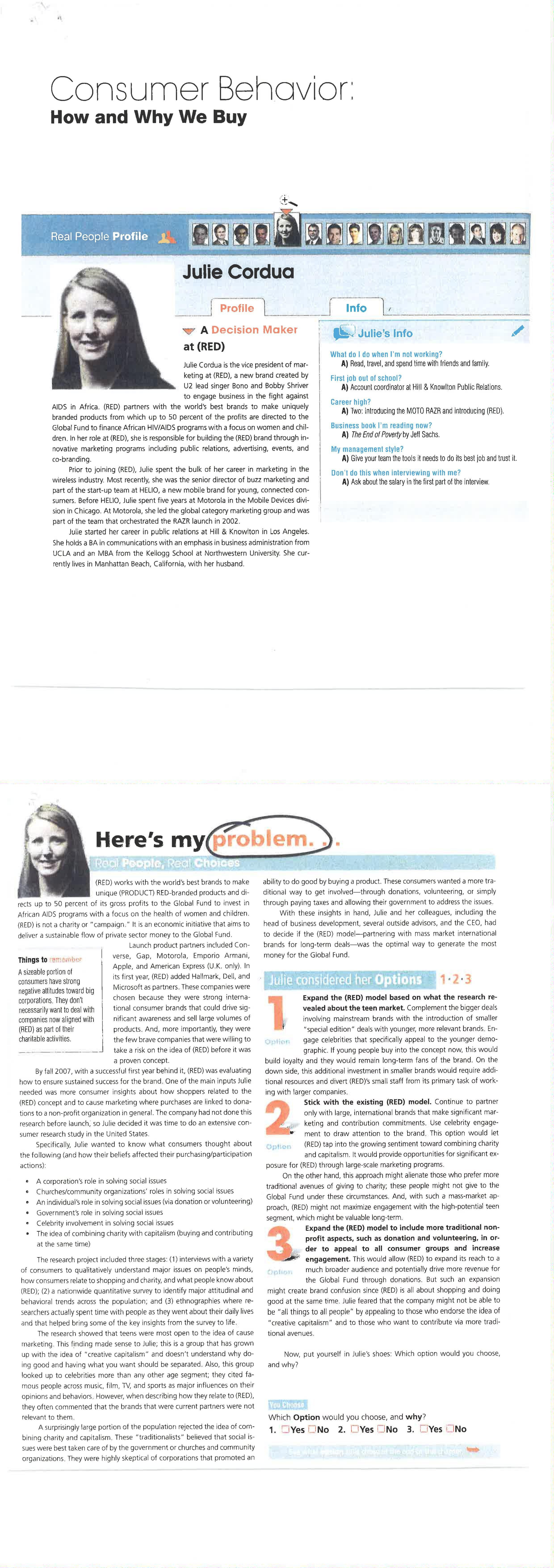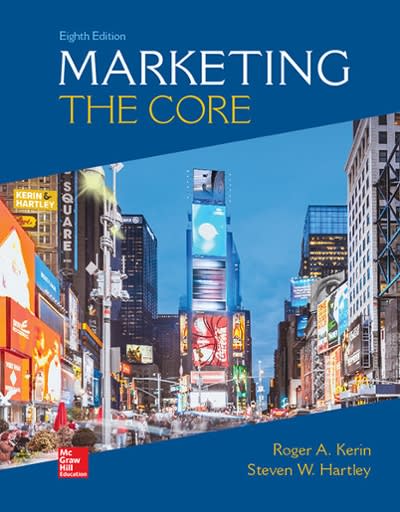- What are three important things about Julia, from her Profile, that you think will shape her decision-process? Why those 3?
- What are the three most interesting things in Julia's Info section, that you think will shape her decision-process? Why those 3?
- Summarise, in one-two paragraphs, the problem Julia faces. Make sure you include the KEY issue, as you see it, and explain why that is the core problem.
- Recommend one of the three suggested Options for Julia. Explain why this option is the best one for her to choose. Explain why the other two are not the best options. Suggest a fourth option she could consider.
Consumer Behavior: How and Why We Buy Real People Profile Julie Cordua Profile Info A Decision Maker Julie's Info at (RED) What do I do when I'm not working? Julie Cordua is the vice president of mar- A) Read, travel, and spend time with friends and family. keting at (RED), a new brand created by First job out of school? J2 lead singer Bono and Bobby Shriver A) Account coordinator at Hill & Knowlton Public Relations. to engage business in the fight agains AIDS in Africa. (RED) partners with the world's best brands to make uniquely Career high? branded products from which up to 50 percent of the profits are directed to the A) Two: introducing the MOTO RAZR and introducing (RED). Global Fund to finance African HIV/AIDS programs with a focus on women and chil Business book I'm reading now? dren. In her role at (RED), she is responsible for building the (RED) brand through in- A) The End of Poverty by Jeff Sachs. novative marketing programs including public relations, advertising, events, and My management style? co-branding. A) Give your team the tools it needs to do its best job and trust it. Prior to joining (RED), Julie spent the bulk of her career in marketing in the wireless industry. Most recently, she was the senior director of buzz marketing and Don't do this when interviewing with me? A) Ask about the salary in the first part of the interview. part of the start-up team at HELIO, a new mobile brand for young, connected con- sumers. Before HELIO, Julie spent five years at Motorola in the Mobile Devices divi- sion in Chicago. At Motorola, she led the global category marketing group and was part of the team that orchestrated the RAZR launch in 2002. Julie started her career in public relations at Hill & Knowlton in Los Angeles. She holds a BA in communications with an emphasis in business administration from UCLA and an MBA from the Kellogg School at Northwestern University. She cur- ently lives in Manhattan Beach, California, with her husband. Here's my problem. Real People, Real Choices (RED) works with the world's best brands to make ability to do good by buying a product. These consumers wanted a more tra- unique (PRODUCT) RED-branded products and di- ditional way to get involved-through donations, volunteering, or simply rects up to 50 percent of its gross profits to the Global Fund to invest in through paying taxes and allowing their government to address the issues. African AIDS programs with a focus on the health of women and children. With these insights in hand, Julie and her colleagues, including the (RED) is not a charity or "campaign." It is an economic initiative that aims to head of business development, several outside advisors, and the CEO, had deliver a sustainable flow of private sector money to the Global Fund. to decide if the (RED) model-partnering with mass market international Launch product partners included Con- brands for long-term deals-was the optimal way to generate the most Things to remember verse, Gap, Motorola, Emporio Armani, money for the Global Fund. A sizeable portion of Apple, and American Express (U.K. only). In consumers have strong its first year, (RED) added Hallmark, Dell, and companies were Julie considered her Options 1 .2.3 negative attitudes toward big Microsoft as partners. Thes corporations. They don't chosen because they were strong interna- Expand the (RED) model based on what the research re- necessarily want to deal with tional consumer brands that could drive sig realed about the teen market. Complement the bigger deals companies now aligned with nificant awareness and sell large volumes of involving mainstream brands with the introduction of smaller (RED) as part of their products. And, more importantly, they were special edition" deals with younger, more relevant brands. En charitable activities. the few brave companies that were willing to option jage celebrities that specifically appeal to the younger demo- take a risk on the idea of (RED) before it was graphic. If young people buy into the concept now, this would a proven concept. build loyalty and they would remain long-term fans of the brand. On the By fall 2007, with a successful first year behind it, (RED) was evaluating down side, this additional investment in smaller brands would require addi- how to ensure sustained success for the brand. One of the main inputs Julie tional resources and divert (RED)'s small staff from its primary task of work- needed was more consumer insights about how shoppers related to the ing with larger companies. (RED) concept and to cause marketing where purchases are linked to dona- Stick with the existing (RED) model. Continue to partner tions to a non-profit organization in general. The company had not done this 2 only with large, international brands that make significant mar research before launch, so Julie decided it was time to do an extensive con keting and contribution commitments. Use celebrity engage- sumer research study in the United States. ment to draw attention to the brand. This option would let Specifically, Julie wanted to know what consumers thought about Option (RED) tap into the growing sentiment toward combining charity he following (and how their beliefs affected their purchasing/participation and capitalism. It would provide opportunities for significant ex- actions): posure for (RED) through large-scale marketing programs. A corporation's role in solving social issues On the other hand, this approach might alienate those who prefer more Churches/community organizations' roles in solving social issues traditional avenues of giving to charity; these people might not give to the . An individual's role in solving social issues (via donation or volunteering) Global Fund under these circumstances. And, with such a mass-market ap- . Government's role in solving social issues proach, (RED) might not maximize engagement with the high-potential teen Celebrity involvement in solving social issues segment, which might be valuable long-term. . The idea of combining charity with capitalism (buying and contributing 3 Expand the (RED) model to include more traditional non- at the same time) profit aspects, such as donation and volunteering, in or- der to appeal to all consumer groups and increase The research project included three stages: (1) interviews with a variety engagement. This would allow (RED) to expand its reach to a of consumers to qualitatively understand major issues on people's minds, Option much broader audience and potentially drive more revenue for how consumers relate to shopping and charity, and what people know about the Global Fund through donations. But such an expansion (RED); (2) a nationwide quantitative survey to identify major attitudinal and might create brand confusion since (RED) is all about shopping and doing behavioral trends across the population; and (3) ethnographics where re- good at the same time. Julie feared that the company might not be able to searchers actually spent time with people as they went about their daily lives be "all things to all people" by appealing to those who endorse the idea of and that helped bring some of the key insights from the survey to life. "creative capitalism" and to those who want to contribute via more tradi- The research showed that teens were most open to the idea of cause tional avenues. marketing. This finding made sense to Julie; this is a group that has grown up with the idea of "creative capitalism" and doesn't understand why do- Now, put yourself in Julie's shoes: Which option would you choose, ing good and having what you want should be separated. Also, this group and why? looked up to celebrities more than any other age segment; they cited fa- mous people across music, film, TV, and sports as major influences on their opinions and behaviors. However, when describing how they relate to (RED), they often commented that the brands that were current partners were not You Chongo relevant to them. Which Option would you choose, and why? A surprisingly large portion of the population rejected the idea of com- bining charity and capitalism. These "traditionalists" believed that social is- 1. Yes No 2. Yes No 3. Yes No sues were best taken care of by the government or churches and community organizations, They were highly skeptical of corporations that promoted an







